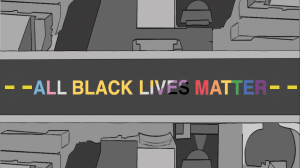
As Lena Bagley ’22 walked to her local grocery store June 14, she passed a long procession of protesters turning onto Fairfax Avenue, brandishing signs emblazoned with the phrase “All Black Lives Matter.” The following day, Bagley noticed the phrase again, this time in the form of a large and brightly-colored street mural on Hollywood Boulevard. She later discovered that this mural was a tribute to the transgender people of color who have lost their lives due to police brutality.
Despite a recent rise in street art advocating for the Black Lives Matter movement, this mural was the first permanent memorialization in Los Angeles dedicated to transgender members of the Black community. On the morning of the June 14 protest, volunteers painted the words “All Black Lives Matter” on the street in the colors of the transgender, non-binary and L.G.B.T.Q. flags, as well as the yellow which has come to represent the Black Lives Matter movement. While the original mural was intended to be temporary, a permanent copy has been installed between Highland Avenue and Orange Drive, commemorating the march.
Bagley said she has observed an increase in powerful street art throughout her neighborhood and the wider Los Angeles area since the resurgence of the Black Lives Matter movement. She said she enjoyed seeing new art amplifying the voices of transgender and queer people of color in her city and appreciates the message behind the new street mural.
“ What struck me about [this mural] is the way it highlights intersectionality and unity in the Black community,” Bagley said. “It forces the public to face the bigger picture and the bigger problem, which we see in the police system as a whole.”
Bagley also said she has come to view street art as more than just a means of protest and feels it is also a way of rewriting and sharing history from diverse perspectives.
“I think the location [of the mural] is great because so many more people will have the opportunity to see it,” Bagley said. “This [protest] was a moment in our community’s history and should be commemorated as such, and the art should reflect the history of [Los Angeles]. I would hope the mural was organized by Black artists who can memorialize the event accurately and as they see fit.”
Art Initiating Change
Sammy Kimball ’21 said that while she supports the message of the mural, she doesn’t view the art as capable of effectively initiating change in the fight against racial injustice. Kimball said she believes there are better ways for activists to support members of the Black community than to fund street art and to donate to Democratic fundraising platforms, such as ActBlue.
“I have no problem with street art,” Kimball said. “We live in a city full of beautiful and diverse street art and artists. I think people should be able to put up the things they want in order to spread their messages, and the message about Black lives mattering is a beautiful and important one. I just don’t think that [activists] are helping the community in the ways they should be and could be. It seems purely political to me, for if they truly wanted to help the community, they would put that money into infrastructure, higher education, Black businesses and job opportunities instead of ActBlue.”
Art in Activism
Honors Art History teacher Katherine Holmes-Chuba stressed the importance of open conversations about the role of art in activism and said that street art is becoming more significant as artists attempt to paint a new and accurate history.
“What’s great about [street art] is it’s opening up conversations about these topics, and people are finally talking and not just passing and observing [without] saying anything about it,” Holmes-Chuba said. “To me, street art is incredibly important because it allows artists to have a voice. There are so many street artists who talk about inequalities. It’s not something that began with Black Lives Matter, but it has become much more prevalent now.”
Historical Significance of Art
Holmes-Chuba said while most art gives people a voice to share their own stories and speak out against injustice, it has also played a role in depicting a skewed account of the country’s narrative, as seen in the controversial Confederate monuments.
“I think a lot of people are just unaware of the history [behind the Confederate monuments] and think that they were built right after the Civil War, but they were not,” Holmes-Chuba said. “They are very much a deliberate attempt to reclaim and re-narrate a history. I’ve been having this conversation with a lot of my peers who, when they studied American history, didn’t really question it. But that’s part of our history.”
Adrienne Usher ’22 said art may serve to create an accurate history of the U.S. in the future, but up to this point, it has played an active role in shifting the narrative of the country’s foundation.
“I think that art has been a long-needed response to a history that has been overly simplified in our school books,” Usher said. “We’ve had many conversations about the Confederate monuments in my history class, and I’ve come to the conclusion that we need to remember all of our history but not venerate the bad parts. There’s no point in trying to dumb down the fact that slavery is a big factor in the foundation of our country. The art is just a reminder of what has happened in the past, and that the pain can’t necessarily fade with time.”































